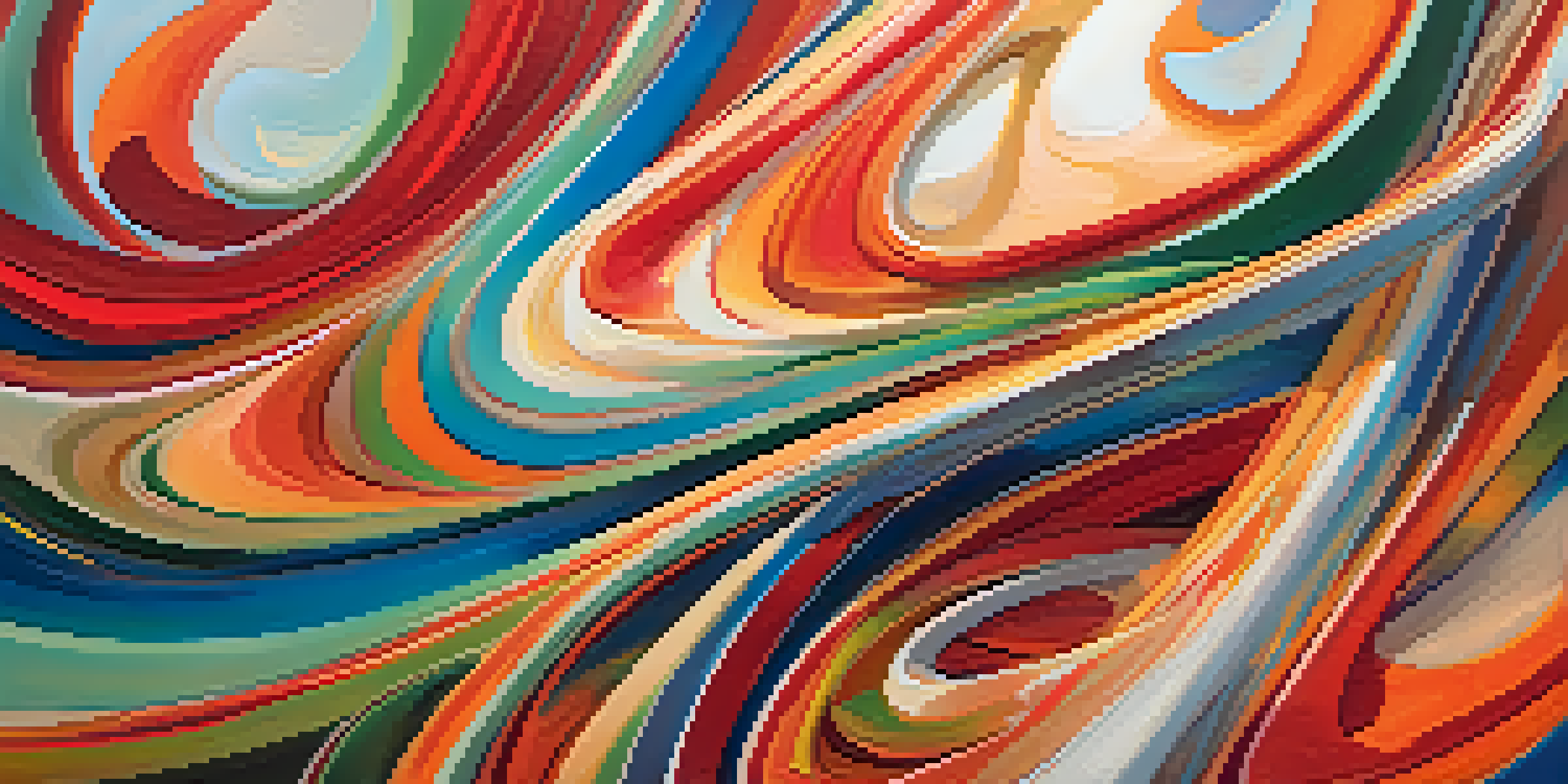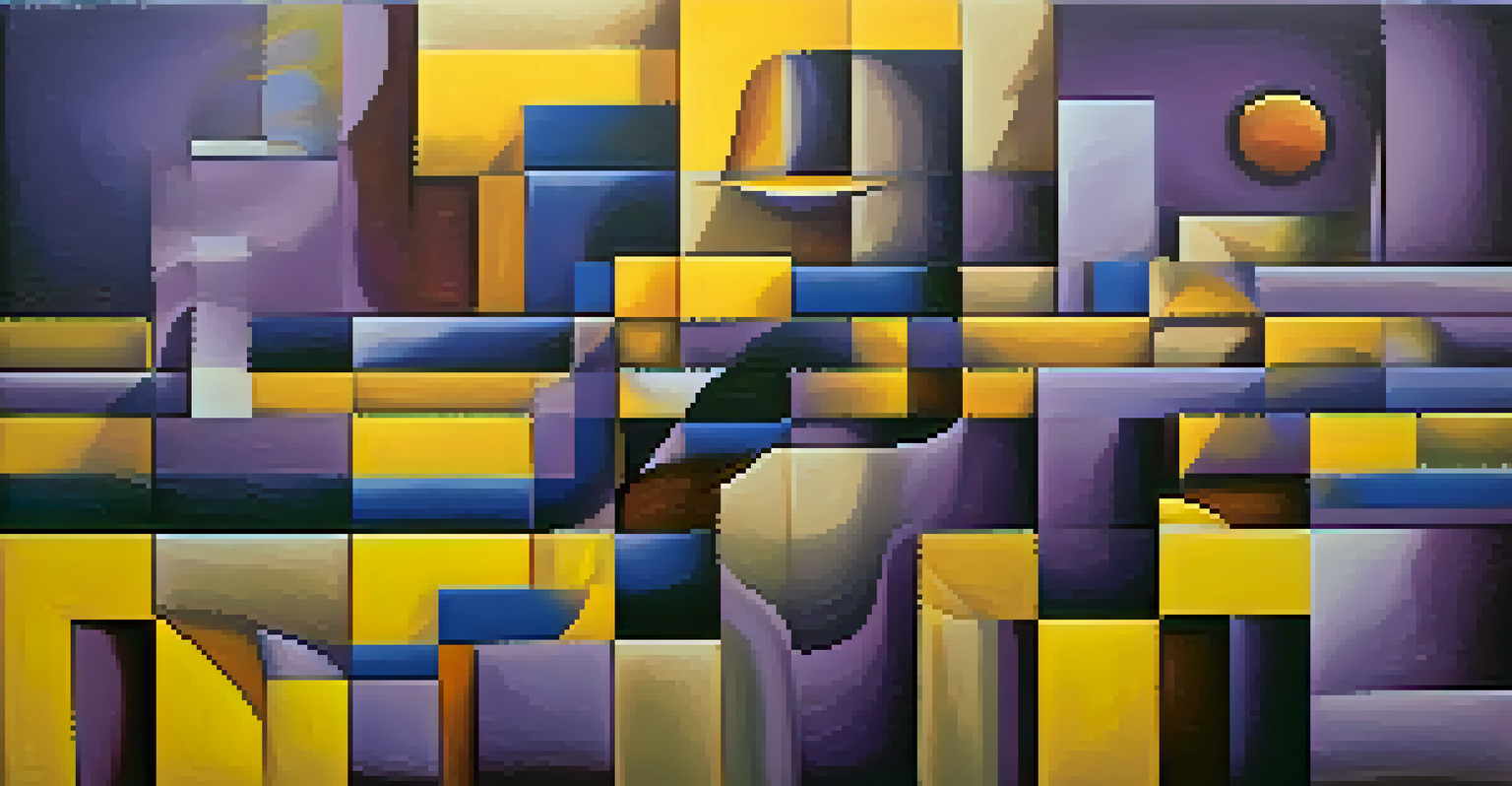Abstract Painting and the Concept of Time in Narratives

Understanding Abstract Painting: A Brief Overview
Abstract painting is an art form that moves away from traditional representation. Instead of depicting recognizable objects, it uses shapes, colors, and forms to evoke emotions and ideas. This style invites viewers to engage with the artwork on a personal level, allowing for various interpretations based on individual experiences.
Art is not what you see, but what you make others see.
One of the most fascinating aspects of abstract painting is its ability to capture complex concepts, such as time. Unlike realistic paintings that depict moments in a linear fashion, abstract art can illustrate the fluidity and subjectivity of time. This opens up a dialogue between the observer and the artwork, leading to a deeper understanding of the passage of time.
As we explore this connection between abstract painting and time, we begin to see how artists manipulate visual elements to create narratives. These narratives aren't always straightforward; instead, they can be layered and complex, reflecting our own experiences and perceptions of time.
The Nature of Time in Abstract Narratives
Time, in a narrative sense, is often linear, but abstract art challenges this notion. It allows for the exploration of time as a cyclical or fragmented experience. Artists can represent different moments simultaneously, inviting viewers to consider how past, present, and future intertwine.

For instance, a swirling composition might evoke feelings of nostalgia, while sharp, jagged lines could represent anxiety about the future. This manipulation of visual elements creates a multi-dimensional experience, where the viewer is not just a passive observer but an active participant in the narrative.
Abstract Art Challenges Time Perception
Abstract painting offers a unique way to explore the fluidity and subjectivity of time, allowing viewers to engage with artworks based on their personal experiences.
By engaging with these abstract narratives, we can reflect on our own relationship with time. The way we experience time—whether it feels fast or slow—can be influenced by our emotions, and abstract paintings capture this subjectivity beautifully.
Symbolism of Colors in Representing Time
Colors play a crucial role in abstract painting, often symbolizing different aspects of time. For example, warm colors like reds and oranges can evoke feelings of urgency or passion, while cool colors like blues and greens may create a sense of calm or reflection. This use of color adds another layer of meaning to the narrative.
The painter tries to master color, form, and texture to create a narrative that transcends the mere representation of reality.
Moreover, the choice of color can also reflect cultural interpretations of time. In some cultures, certain colors are associated with specific times of day, seasons, or life stages. Understanding these associations can enrich our appreciation of an abstract painting and its narrative potential.
As viewers, we can consider how these color choices resonate with our own experiences of time. Just as a sunset can evoke feelings of endings or transitions, an abstract painting’s color palette can transport us through our personal histories.
The Role of Texture in Conveying Temporal Layers
Texture is another essential element in abstract painting that can convey the concept of time. Different textures can create feelings of depth and complexity, mimicking the layers of our own temporal experiences. For instance, a rough, chaotic surface might represent a turbulent period in life, while a smooth, flowing texture could symbolize tranquility.
Artists often use various techniques—like layering paint, scraping, or incorporating mixed media—to enhance texture and evoke a sense of time. This tactile quality invites viewers to explore the physicality of the artwork, engaging with it on a sensory level.
Colors Symbolize Emotional Time States
The use of color in abstract paintings can evoke different feelings associated with time, enriching the narrative by reflecting cultural interpretations and personal histories.
By analyzing how texture is employed in abstract paintings, we can gain insights into the artist's emotional journey through time. This understanding can deepen our connection with the work and provide a richer narrative experience.
Time Perception: Viewer Interpretation and Experience
An essential aspect of abstract painting is how it invites personal interpretation. Each viewer brings their own experiences and perceptions of time, which can significantly alter their understanding of the artwork. This subjective experience is what makes abstract art so powerful and relatable.
For example, one viewer might see a sense of urgency in a chaotic composition, while another might find peace amidst the turmoil. This diversity of interpretation reflects the complexity of human emotions and our unique relationships with time.
As we engage with abstract paintings, we can reflect on how our individual experiences shape our understanding of time. This personal connection not only enhances our appreciation for the artwork but also encourages us to explore our own life narratives.
Interplay of Movement and Time in Abstract Art
Movement is a fundamental aspect of both time and abstract painting. Artists often use lines and shapes to create a sense of motion, capturing the fleeting nature of time. This dynamic quality can evoke feelings of change, growth, or transition, further enriching the narrative.
For example, diagonal lines might suggest speed or urgency, while circular forms could represent continuity and cycles. By incorporating movement into their work, artists can communicate the ever-changing nature of time in a visually compelling way.
Texture Reflects Temporal Experiences
Texture in abstract art adds depth and complexity, mimicking the layers of our temporal experiences and inviting viewers to connect with the artist's emotional journey.
As viewers, we are drawn into this interplay of movement and time, reflecting on our own experiences of change. This connection invites us to consider how we navigate the passage of time in our lives, making abstract art a powerful medium for exploring these themes.
Conclusion: Embracing Time Through Abstract Narratives
In conclusion, abstract painting offers a unique lens through which we can explore the concept of time. By engaging with the emotional, textual, and visual elements of these artworks, we can uncover complex narratives that resonate with our own experiences. This exploration encourages us to reflect on the fluidity of time and our individual journeys.
As we continue to appreciate abstract art, we should embrace the diverse interpretations and meanings it holds. Each painting becomes a conversation between the artist and viewer, where personal reflections on time can emerge and flourish.

Ultimately, abstract painting not only captures the essence of time but also invites us to engage with our own narratives. By exploring these connections, we deepen our understanding of both art and the human experience.